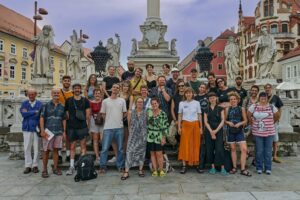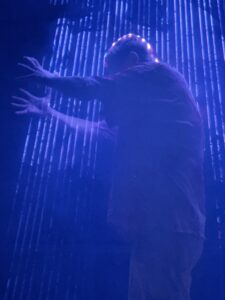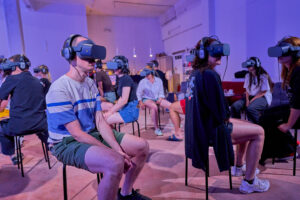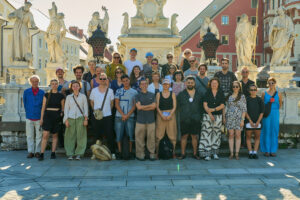Where Art Meets Innovation: Highlights from the DIGITAL on STAGE Mobility Programme
The DIGITAL on STAGE Mobility Programme in Maribor brought together a vibrant community of artists, cultural professionals, and digital innovators from across Europe, for two intensive weeks of learning, experimenting and co-creating.
Part of the three-year Creative Europe project DIGITAL on STAGE (Project ID: 101173738), this initiative aimed to reimagine the performing arts through the integration of cutting-edge digital tools. In response to the post-pandemic shift toward hybrid and virtual experiences, the programme focuses on equipping artists with skills in Virtual Reality (VR), Augmented Reality (AR), Artificial Intelligence (AI), robotics, interactive installations, and streaming platforms — turning technology from a backstage assistant into a central character in performance.

A Week of Immersion
Over five working days, for two consecutive weeks, participants engaged in lectures, workshops, design-thinking sessions, and hands-on labs guided by international mentors. Topics ranged from blending physical and virtual realities, AI-enhanced choreography and scenography, and building immersive 3D worlds, to multimedia performative installations and streaming as a creative tool.
The sessions combined theory with practical application, encouraging artists to design, test, and showcase ideas that blur the lines between performer and audience, reality and simulation.

Technologies that Sparked Inspiration
The impact of the Mobility Programme is best captured through the voices of its participants. For many, the VR performances were a revelation. As one participant described, “We wore the headsets and found ourselves in another time and space. It showed how theatre and concerts could reach audiences far beyond the venue.” (Katerina). Tools like Unicorn Hybrid Black, capable of reading brainwaves, amazed participants with their creative potential, while encounters with robotic dogs and dancing robots challenged notions of movement, interaction, and narrative.
Artists left Maribor with a broader vision of what performance can be. Technology was not seen as an add-on, but as a structural element of storytelling. Several participants spoke of incorporating VR, AR, and AI into the dramaturgy itself, using them to question reality, embodiment, and audience participation.

The Human Connection
Beyond the technology, the week was defined by collaboration and shared creativity.
From impromptu contact improvisation jams in the park, to filming site-specific performances in public spaces, to cross-team technical problem-solving, the environment fostered openness and generosity.
As one artist put it: “The diversity of backgrounds and ideas made us feel like part of a living, evolving community.” (Christina).

Looking Ahead
By the end of the Mobility Programme, many participants had not only developed project concepts but also formed bonds that could spark future collaborations across borders. With international networking, access to high-end equipment, and support for experimentation, the Mobility Programme proved to be more than training — it was a launchpad for new artistic visions in the digital age.
Funded by the European Union under the Creative Europe Programme, DIGITAL on STAGE will continue to champion these cross-sector encounters, showing that when art meets technology, the possibilities are as boundless as the imagination.

